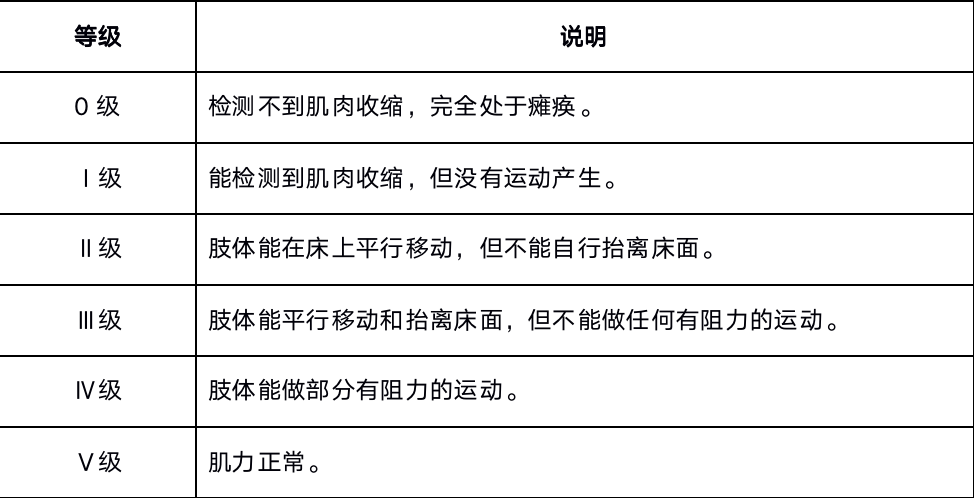Muscle atrophy
SYMPTOMS
What are the manifestations of muscle atrophy?
The manifestations of muscle atrophy usually depend on the degree of atrophy[1].
- Mild atrophy. Although there is no visible indentation in the muscles, they feel loose, with muscle weakness, and the ability to perform voluntary movements remains.
- Moderate atrophy. Partial atrophy and loss of muscle fibers occur, with visible indentations on the muscle surface. The muscles feel longitudinally contracted and transversely reduced, accompanied by obvious muscle weakness and inability to perform voluntary movements.
- Severe atrophy. Most of the muscle fiber tissue atrophies, exposing the related bones. Only a small amount of muscle fibers remain in the muscle tissue, with severe muscle weakness. The patient loses the most basic coordination and movement abilities.
- Complete atrophy. The muscle fiber tissue completely atrophies, resulting in a total loss of motor function related to the muscles.
Does muscle atrophy affect movement?
Muscle atrophy generally affects movement[2]. Muscle atrophy leads to weakened muscle strength and uneven exertion, making movement difficult for patients. It also disrupts balance in posture, increasing the risk of falls and causing significant limitations in movement, which brings many inconveniences to patients.
TREATMENT
How to Treat Muscle Atrophy?
The treatment of muscle atrophy usually begins with identifying the underlying cause, followed by determining an appropriate treatment plan based on the specific condition.
For example, if it is caused by congenital factors, rehabilitation therapies such as massage, physical therapy, and exercise may be considered. If it results from neurological diseases, medications or comprehensive treatments[3] may be recommended. For atrophy caused by infections, anti-infection treatments are generally required. If it stems from immune system disorders, immunomodulatory drugs may be necessary. In cases caused by cervical or lumbar spine diseases, surgical intervention[1] might be needed.
How to Care for Muscle Atrophy?
Patients with mild muscle atrophy who can still manage daily activities should prioritize safety during movement to avoid falls.
Patients with moderate to severe muscle atrophy may require assistance with care, depending on their condition. This includes measures such as frequent repositioning, maintaining airway patency, and preventing aspiration.
- Frequent repositioning. For patients paralyzed due to muscle atrophy and unable to move independently, regular repositioning is essential to prevent bedsores.
- Maintain airway patency. For patients with respiratory muscle atrophy, monitor for signs of breathing difficulties, ensure airway clearance, and facilitate sputum expulsion.
- Prevent aspiration. Patients with swallowing difficulties should be fed carefully to avoid choking.
Additionally, a balanced diet rich in high-quality proteins and vitamins—such as meat, eggs, dairy, and vegetables—is recommended. For patients with limited mobility, ensure their living environment is well-ventilated and warm.
DIAGNOSIS
What symptoms of muscle atrophy require medical attention?
Patients with muscle atrophy should seek prompt medical attention if they experience any discomfort[1].
After muscle atrophy occurs, patients may experience symptoms such as muscle weakness, fasciculations, and limb immobility. Prolonged conditions can lead to chronic muscle malnutrition, thinning of muscle fibers, and in severe cases, complete paralysis.
For bedridden patients, complications such as cumulative pneumonia, pressure sores, dyspnea, and heart failure may also arise. Therefore, any discomfort should prompt immediate medical consultation.
What tests are needed for muscle atrophy?
Muscle atrophy typically requires examinations such as muscle strength testing, muscle tone assessment, and laboratory tests[1].
- Muscle strength testing. Patients should undergo muscle strength evaluations, with normal human muscle strength generally rated as grade V. Muscle strength below the normal range may indicate pathology. (See the muscle strength grading table below[4].)

- Muscle tone assessment. Muscle tone enables the body to perform movements and maintain postures. Patients with muscle atrophy may exhibit reduced muscle tone, though some with upper motor neuron damage may show increased tone.
- Laboratory tests. These primarily include electromyography (EMG) and nerve conduction studies, which are crucial for diagnosing muscle atrophy. These tests help confirm muscle damage and determine its cause, such as neurogenic or myogenic injury.
- Pathological examination. A biopsy involves extracting a small muscle tissue sample for thin-section analysis to accurately diagnose the cause of muscle atrophy.
POTENTIAL DISEASES
What are the complications of muscle atrophy?
Muscle atrophy can lead to complications such as fractures, aspiration pneumonia, and malnutrition.
- Fractures. Patients with muscle atrophy and limb weakness may lack strength during daily activities like squatting or climbing stairs, increasing the risk of fractures from falls. Therefore, patients should walk with family assistance when possible, use protective gear to prevent fractures, and engage in gradual exercise to strengthen limb muscles, slow muscle atrophy, and improve muscle strength.
- Aspiration pneumonia. If the patient has atrophy in the pharyngeal and laryngeal muscles, they are prone to aspiration pneumonia, along with choking, difficulty breathing, and respiratory failure. Patients with weak respiratory muscles can practice blowing balloons to strengthen them and should eat slowly to avoid food entering the lungs.
- Malnutrition. If the patient has limb muscle atrophy, it may worsen muscle malnutrition and further restrict mobility.